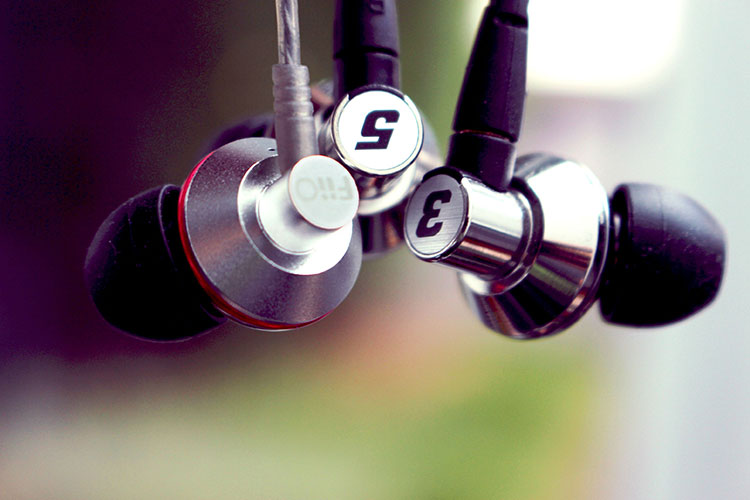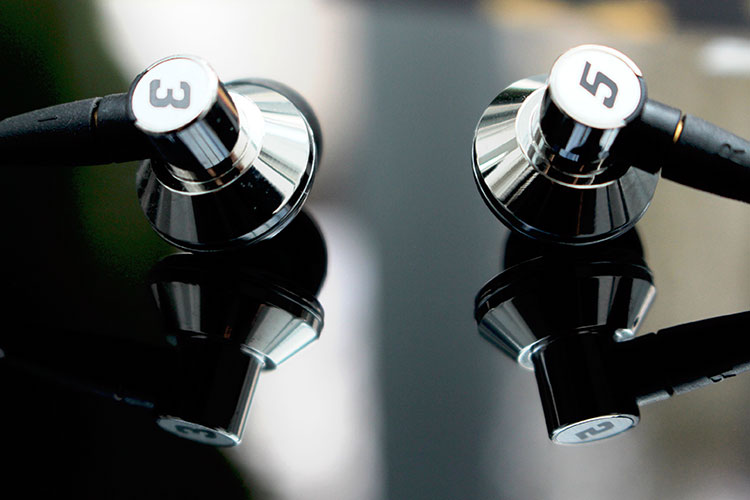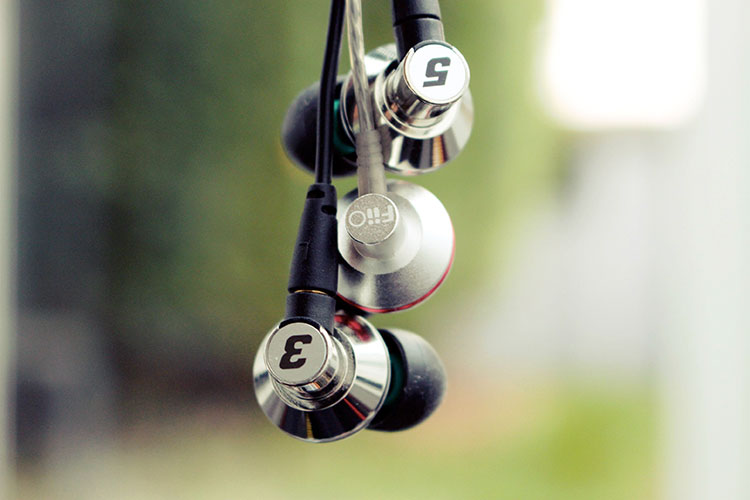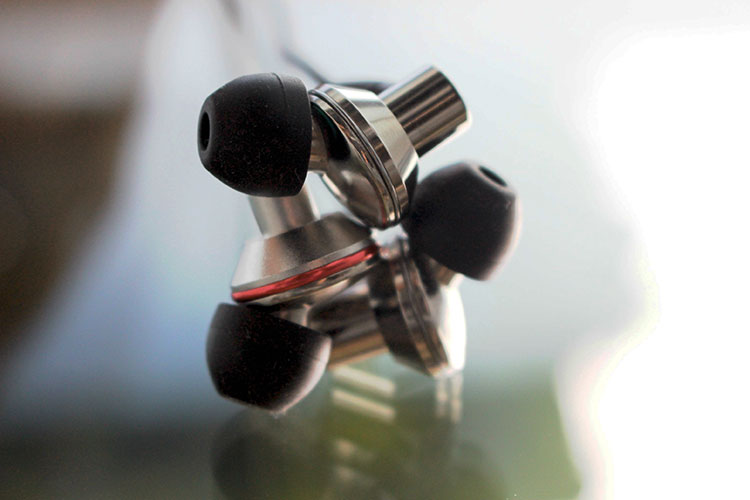In early 2015, DUNU launched an extremely well-regarded model that pushed the envelope of innovation with its bold driver configuration and daring outer shell design. Touted the DUNU Titan 1, the model incorporates a single 13mm titanium-treated dynamic driver within a half in-ear semi-vented design. The result being a very spacious and enveloping sound with an energetic and fast-transient vocal response.
Earlier this summer, fellow Chinese audio company FiiO took the task of reinvigorating the Titan 1 IEMs which birthed the Fiio EX1 in its latest series of IEMs. One of the main differences between the EX1 and the Titan 1 is that the former now sports an updated transparent sheathed cable with a metal Y-split for the purposes of durability. The housings have been sand-blasted to create a smoother finish and the Fiio logo is now embellished on the outer portion of the Fiio EX1’s space-age housing. One thing that remains faithful to the original DUNU model, however, is the coveted sound that has inspired the next generation in DUNU’s Titan series.
These include the DUNU Titan 3 and DUNU Titan 5 which have been exhaustedly retuned by their in-house design team to deliver two different flavours of “Hi-Res AUDIO” certificated sound. Despite the 3 and 5 monikers, both the Titan 3 and Titan 5 retain a single 13mm titanium treated transducer that renders a resolving sound signature.
In terms of market pricing, the DUNU Titan 1 oddly enough retails more than its now improved Fiio EX1 counterpart; both go for $115 and $80 respectively. The Titan 3 and Titan 5, however, retail at the same price of $135.
The Box & Accessories
From the packaging, it is evident that Fiio is much more of a polished brand than DUNU. Perhaps this is due to benefiting from economies of scale from its large consumer portfolio. The EX1s come in a more compact and professional looking box than its Titan 1 counterpart. Included as part of the accessories are 8 pairs of silicone eartips, a shirt-clip and small earbud carrying case.
The DUNU packaging for the Titan 3 and Titan 5, however, is still reminiscent of the Titan 1 and DUNU house brand; a matt-black box with a busy design. Both incorporate a magnetic latch which when opened reveals a display window that houses the Titan IEMs. Included as part of the accessory items are 6 pairs of silicone eartips, a shirt clip, a 3.5mm to 6.5mm adapter, 1 pair of ear stabilisers and a carrying case.
The Build & Design
The Fiio EX1 has an outstanding build which combines several areas of technology to build a durable and high-quality IEM. The body of the housing, for example, is precisely CNC milled with a back made of anodized duralumin and the front of stainless steel. The Kevlar-strengthened OFC cable is another example of Fiio’s brilliantly implemented high strain resistant and durable components.
DUNU have followed in the same vein with their Titan 3 and Titan 5 IEMs which utilise a metal injection moulded stainless-steel construction. The cable however, could have been improved like Fiio did with the DUNU Titan 1 to truly make the Titan 3 and Titan 5 a durable product. One thing which was well-implemented, however, was the notion of detachable cables. This allows broken cables to be replaced with a stock one or a compatible third party one. Both the Titan 3 and Titan 5 look identical in design apart from the distracting numbers on the back of each IEM.
The Fit & Isolation
Due to the half in-ear design of these earphones, only a shallow fit can be achieved with all 3 IEMs. The larger housings of the Titan 3 and 5, however, are slightly less comforting than the smaller and rounder frame of the Fiio EX1.
Isolation wise, the EX1 loses out because of its 11 vented hole design surrounding the angled nozzles. Both the Titan 3 and Titan 5 have only 1 of these holes in the design of the stainless steel body which means that isolation is much better on these two IEMs.
Sound impressions
The Lows
The DUNU Titan 5 delivers bouts of well-tuned sub-bass which extends well with good texture and depth. Next to the DUNU DN-2000, the Titan 5 is slightly more controlled and tighter than the former’s bass section. Impact levels, however, are stronger on the DN-2000 with its more involving and still articulate sub-bass frequency range. There is a perceptible mid-bass hump within the Titan 5 which although has similar quantities with that of the DN-2000, is perceptively faster with its quicker decay speeds and resolution.
The bass of the Titan 3’s is to the Titan 5’s just as the bass of the DN-2000J’s is to the DN-2000’s. In other words, the Titan 3 has more of an intelligible bass section than that of the Titan 5 with its quicker decays and faster transient responses. With that said, the bass of the Titan 3 does not enjoy the same quantity as that of the Titan 5 or the DN-2000 for that matter. However, the Titan 3’s bass is still very well-tuned with an extensive sub-bass that digs deep when called for. I am very impressed with the balance between musicality and resolution here which the Titan 3 seems to nail perfectly. For that reason, the bass of the Titan 3 is reminiscent of the DUNU DN-2000J’s incredibly articulate, resolving and extensive bass response. However, the Titan 3 still falls short of the DN-2000J’s infinitely clearer and more responsive bottom-end.
The Fiio EX1’s bass is more similar to the Titan 3 than the Titan 5. Like both Titans, the EX1 has a well-extended low frequency range. However unlike the Titan 3, it is warmer and less resolving.
For analytical listeners who crave for intelligibility and high resolution, I would recommend the Titan 3’s bass which is evenly balanced with respectably quantity. For those looking for bigger body bass with a strong mid-bass punch, the Titan 5 is the IEM that fits the bill.
The Mids
One thing that prevented the earlier DUNU Titan 1 IEM from becoming a daily driver was its sheer mid-laidback sound signature. Since the Fiio EX1 possesses this same signature, its midrange too is something that I wished could have been improved upon. While not necessarily recessed by any means, the EX1/T1’s midrange often lacked emotionality due to its diffuseness and relaxed position in the spatial soundstage. Despite this, I highly praise the EX1/T1 as an IEM because of its crisp yet smooth signature which is perfect for background listening. By this I mean, it is great to listen for when you don’t have to concentrate on the music alone but just for the purposes of background music. The holographic feel of the sound on the EX1/T1 aids in this aspect and is one of the reasons why the Titan 1 has been so highly revered since its launch back in early 2015.
It was no surprise then that the launch of both the Titan 3 and Titan 5 had me excited because of my respect for the Titan series. On listening to the Titan 3, I was dumbfounded that a single dynamic driver could be capable of producing such a sound. No longer is the midrange further back in the overall mix as with the EX1/T1 but vocals are right in centre stage with body and weight while still retaining that crisp yet smooth sound signature. Clarity levels are heightened in the Titan 3’s more forward mid-section. However, the Titan 3 cannot really be attributed as a vocal-centric IEM since its sound is seemingly balanced across the frequency spectrum. Unlike the Titan 1/Fiio Ex1, the Titan 3 has less of a leading edge in vocals but remarkably retains outstanding levels of clarity. I am most impressed with the Titan 3’s ability to bite without compromising fatigue levels or harshness.
Like the Fiio EX1, the Titan 5 presents with a u-shaped sound signature whose midrange falls behind the large bass and extensive treble response. Unlike the Fiio EX1, though, the Titan 5’s midrange vocals are warmer and rounder owing to the bigger sub- and mid-bass sections. Both the Titan 3 and Titan 5 have been excellently retuned as they both lack the metallic sheen in the upper midrange that the Titan 1/Fiio EX1 often spewed out. For this reason, I would say that both the Titan 3 and Titan 5’s midrange can be considered an upgrade to that of the EX1’s.
The Titan 3 has a less well rounded but consequently clearer midrange than the Titan 5. This means that vocals on the former sound more articulate, more engaging and better defined. Like the DN-2000, the Titan 5’s u-shaped imposition make vocals a bit less involving and impactful. In this sense, the Titan 3 can be likened again to its older brother, the DUNU DN-2000J, for its detailed mid-section representation.
The Highs
In sibilant and treble-prone tracks, the Fiio EX1 shows its bad characteristics with quite a grating boost in the lower treble frequencies. The Titan 3 takes this and artfully refines the treble section so that it is neither harsh nor grating. Instead the small boost in the lower treble is tactfully done to increase clarity in this proportion without compromising edginess. The Titan 5’s treble takes this even further with a smoother and more organic feel next to that of the Titan 3’s crisp high-end. As a consequence of this, the Titan 3’s treble has higher levels of perceived extension although the two fall around the same ballpark in quantity.
Next to the DN-2000J, the Titan 3 boasts better levels of control and restraint despite possessing slightly less amount of details. Though the 2000J is technically superior to the Titan 3, I find myself more drawn to the signature of the Titan 3 which intertwines some musicality amongst clinical precision. That in itself, is a testament to how great the Titan 3 is at not just the sub $150 mark but well beyond.
Soundstage & Imaging
Of the three, the DUNU Titan 1/Fiio EX1 wipes the floor when it comes to an expansive and airy soundstage. As mentioned, the Fiio EX1 delivers a holographic feeling stage with well projected sonic cues in the dimension of width and height. As a result of only one vented hole in each of the bodies of the Titan 3 and Titan 5, some of this airiness is lost resulting in less of an open sound. This is not to say that the soundstage of the Titan 3 and 5 is lacking, however, as it still boasts an above average soundstage with decent projection of sonic cues. Owing to the Titan 3’s midrange, it feels the more closed in of the three but again, is by no means deficient in the soundstage department. Instead, separation levels are actually the best on the Titan 3 with its clear and precise rendition of vocals and instruments.
DUNU Table of Comparisons
As of a result of the now extensive collection of DUNU IEMs, I have set up a table to draw quick and easy comparisons between the sounds of the DUNU DN-2000J, DUNU DN-2000, DUNU Titan 5, DUNU Titan 3 and DUNU Titan 1 (Fiio EX1) IEMs.
NB: The Titan 1 = Fiio EX1
| Least | Most | ||||
| Bass quantity | Titan 1 | Titan 3 | DN-2000J | Titan 5 | DN-2000 |
| Bass resolution | DN-2000 | Titan 1 | Titan 5 | Titan 3 | DN-2000J |
| Midrange clarity | Titan 1 | DN-2000 | Titan 5 | Titan 3 | DN-2000J |
| Mid-centricity | Titan 1 | Titan 5 | DN-2000 | DN-2000J | Titan 3 |
| Treble clarity | Titan 5 | Titan 1 | DN-2000 | Titan 3 | DN-2000J |
| Treble Extension | Titan 5 | Titan 1 | Titan 3 | DN-2000 | DN-2000J |
| Musicality | Titan 1 | DN-2000J | Titan 3 | Titan 5 | DN-2000 |
| Soundstage | Titan 3 | Titan 5 | Titan 1 | DN-2000J | DN-2000 |
Please take these as relative to one another and not absolute values. For example, although Titan 3 has the smallest soundstage out of the 5 IEMs here, it is still above average in the IEM world. The same can be said for the DN-2000’s bass articulacy which although the worst on here, is still much better than average.
Matching
The Titan series of IEM all have varying levels of sensitivity with the Fiio EX1 being the hardest to drive followed by the Titan 5 and consequently the Titan 1. Unlike other IEMs though, they sound good from any standard device such as a smartphone or laptop output. DAPs such as the iBasso DX90 do bring about some openness and clarity, although differences are less subtle when compared from my ASUS laptop. From a smartphone perspective, the results are more obviously clear with the DX90 being the default go-to option for a portable solution.
Final Thoughts
Taking all factors into consideration, I am very impressed with each model especially for their prices. I am even more enthralled that a well-tuned single dynamic transducer is able to sound like a hybrid IEM that can easily compete with more expensive ones. From the three, the Titan 3 is easily my favourite with its clear and articulate midrange amongst an extensive treble and bass section. They are the one of the best IEMs I have ever heard in the category of sub $200 IEMs. The Titan 5, while tuned differently, does not fall that far behind with its strong and enveloping low frequencies amongst a more laidback midrange.
The Titan 1/EX1 is no slouch either with its still clear and intelligible sound amongst a vast & airy soundstage. What the EX1 lacks for in midrange, though, is made up for in the Titan 3 with its more pronounced midrange and lack of metallic sheen in the higher frequencies. Build quality is great on all three IEMs with the Fiio EX1 winning for its plastic ensheathed OFC cable. While DUNU have done great by supplying a detachable cable, I would have preferred them to create a more compelling cable design like that of the Fiio EX1. Regardless, I would heartily recommend and indeed urge readers to buy any of one of these IEMs on the basis of their tonality and outstanding value for money.









